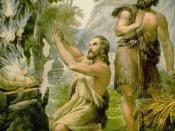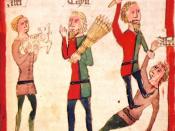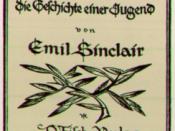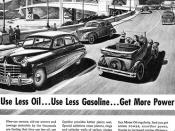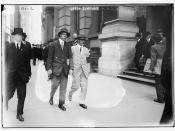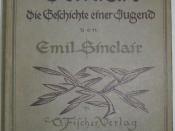Demian "ÃÂ Hermann Hesse "Yin and Yang arise together. There cannot be one without the other. Darkness exists because there is light; emptiness exists because there is fullness. This is the Tao."ÃÂ - Anon.
For every good there is evil, and for every evil there is good. Both good and evil co-exist. By denying the evil, one cannot eradicate it. Therefore, evil should be understood. The understanding of evil creates awareness. If one accepts only the good and discards the rest, only half of the world will be accepted and/or understood. Therefore, acceptance should be in its entirety. In the novel Demian by Hermann Hesse, the co-existence of good and evil had a great impact on Emil Sinclair's life. His life possessed two realms: the "world of light"ÃÂ and the "world of darkness."ÃÂ The "world of light"ÃÂ was a more familiar realm to him because it consisted of his parents, religion, good manners, cleanliness, love, reverence, and wisdom.
The "world of darkness"ÃÂ creeped into his home through the servant girls and workmen with ghost stories, rumors of scandal, slaughterhouses, prisons, murders, and suicides. Both "worlds"ÃÂ coincided with eachother within his home. The balance of two realms living together in one world is known as Abraxas. Pistorius, Sinclair's friend, taught him about religion and told him of Abraxas. Kromer, a bully, lets "darkness"ÃÂ seep into Sinclair's "world of light."ÃÂ But, Demian, a God-like figure, relieved Sinclair of him. In Demian, Hesse explores the theme of good and evil effectively by the use of contrasting characters, symbols, images, and the inner conflict of Emil Sinclair.
According to the bible, good and evil have co-existed from the beginning of time, when man was created. In the book of Genesis, Moses writes about the story of Cain and Abel. "But the Lord said to him, "Not so; if anyone kills Cain, he will suffer vengeance seven times over."ÃÂ Then the Lord put a mark on Cain so that no one who found him would kill him."ÃÂ (Genesis 4:15) Most people interpret Cain to be evil, for killing his brother, and the mark that he bore was a punishment. But, Demian believed that Cain was "awarded a special decoration for his cowardice, a mark that protects him and puts the fear of God into all the others."ÃÂ He believed that it was something in Cain's face that struck people to think that he was faintly sinister, more intellectual, bold and powerful than others. The story refers to Cain and Abel in order to compare and contrast Demian and Kromer. Kromer was a bully towards Sinclair and continually tormented him. When Sinclair met Demian, he relieved him of Kromer and was never bothered by him again. Demian is portrayed as a Cain-like figure. He bore a sign that struck people with awe. "He had the sign on his forehead. It was Max Demian."ÃÂ Demian gave the impression that he was more experienced in life and, therefore, more knowledgeable. Throughout Sinclair's childhood, the good was Demian and the evil was Kromer. In this case, Demian got rid of Kromer, as did Cain to Abel. Although the evil was rid of at the moment, both Cain and Kromer, different forms of evil were expected in the near future. Therefore, with reference to the bible, and the contrasting of Kromer and Demian, Hesse proves that one cannot have the good without evil.
"The bird fights its way out of the egg. The egg is the world. Who would be born must first destroy a world. The bird flies to God. That God's name is Abraxas."ÃÂ When Sinclair sent his painted picture to Demian, a bird struggling to free itself from an egg, Demian had responded with the quote above. With this quote, he was the first person to introduce the idea of Abraxas to Sinclair. Through Sinclair's quest to educate himself about Abraxas, he learns that He is a God whose job is to unite the godly and devilish elements. "Abraxas speaketh that hallowed and accursed word which is life and death at the same time. Abraxas begetteth truth and lying, good and evil, light and darkness in the same word and in the same act."ÃÂ How can one be given a god to worship, if he represents only one arbitrarily separated half of the world? Hesse proves that one should worship the whole world, a god who is also a devil or a cult of the devil and a cult of god, in this case, Abraxas. Once one accepts Abraxas, one will have a better understanding and awareness of the world.
Sinclair's whole life was depicted as a double-sided world. "The realms of day and night, two different worlds coming from two opposite poles, mingled during this time."ÃÂ As a child, he was enveloped in the "world of light"ÃÂ -- mother and father, love and strictness, model behavior, and school. But, knew that the world of "darkness"ÃÂ existed. Hesse utilises symbolism with the sparrow hawk, a design above the doorway of Sinclair's home, to portray the combination of innocence and cruelty. It depicts the coming together of good and evil, an overlapping of the two realms. The sparrow is a gentle, innocent bird and the hawk, on the other hand, is a cannibalistic bird. This shows that the two worlds of good and evil, gentleness and savagery actually exist as one. Though the atmosphere inside Sinclair's home is of peace and goodness, he starts living in the world of torture and guilt. Throughout Sinclair's life, both realms are at war. For example, when he had first, blindly, seen Beatrice, he was tormented by lust. But, when he had begun to see her feminine beauty, he had found the pure love that he bared for her. Because of this experience, he cuts off all connections to the "dark world."ÃÂ At different instances within the novel, Sinclair feels enveloped in the world of darkness, but there was always someone there to guide him towards the other realm. Sinclair, himself, believed that the world was divided into two realms. At times he lived in the "world of light"ÃÂ and at others the "world of darkness"ÃÂ, these two worlds constantly coincided and co-existed within his life.
Hesse creates a better understanding of the good and the evil by depicting how the two polar opposite qualities co-exist. Everything has it's opposite and they cannot be fully understood without the other: God to Satan, good to evil, and light to darkness. The co-existence of good and evil is a major theme, which runs throughout the novel. Hesse shows that they both exist together through the use of contrasting characters, symbols, images, and the inner conflict of Emil Sinclair. In the world and in life, both good and evil exist, but one cannot live without the other.
